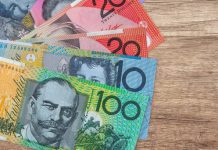The week starts on quite a mixed sentiment in Asia. Japanese stocks rebound as reaction to the LDP victory in keeping an outright majority in lower house. The Nikkei rallied 2.5%, while Chinese equities remained under pressure as the official manufacturing PMI revealed a read below the 50 mark for the second month, pointing at an unpleasant slowdown in activity due to power shortages and rising commodity prices.
Elsewhere, the US equities had quite a flattish session on Friday, but all three major indices posted gains to the weekly closing bell. Nasdaq even posted a fresh record despite the disappointment on Apple and Amazon earnings, which saw their stock prices gap significantly lower at the open, but then recover to the close. Exxon and Chevron had a strong quarter as well.
Earnings continue flowing in this week, but a major part of the game is already played. 80% of the S&P500 companies that reported earnings so far, beat expectations.
Now the focus could shift to the macroeconomic calendar. We have important meetings this week: Reserve Bank of Australia (RBA), Federal Reserve (Fed), Bank of England (BoE) and OPEC meet.
Will OPEC increase output?
OPEC will meet on November 4th. The expectation is that the oil producer companies should restore some more of the production they halted during the pandemic months as the deepening energy crisis and the rising demand should put even Saudi’s mind at ease that the supply could be increased without too much harm on the price levels. The barrel of US crude remains on a steep rising path, and the rally is broadly expected to extend toward the $90 per barrel mark.
And that sustained upside pressure in energy prices should continue keeping the inflation expectations high and the central bank hawks alert.
Fed to start taper, but focus on the timing of the first rate hike
The Fed is expected to announce tapering its massive bond purchases this week. The tapering should be gradual, and that expectation is already priced in. Unless we see an aggressive pullback from the Fed, which I doubt, the market reaction should not be too aggressive, as the hawkish expectations have been already being priced in quite aggressively over the past couple of weeks.
Small parentheses: And that hawkish pricing is especially true for the European yield spread which is completely going against Christine Lagarde’s, seriously unjustified, dovishness on the policy.
What really matters for the Fed is the timing if the first rate hike. At this point, it looks pretty much unrealistic keeping the rates unchanged until 2023 and the market is already pricing in two 25bp rate hikes by the end of 2022. According to the activity in Fed funds futures, the first rate hike could come as soon as in June next year. Let’s see whether Jerome Powell will do the same comedy than Christine Lagarde and try to convince the market that everything is fine – whereas it is not, or will he be a bit smarter and accept the fact that we have a rising inflation problem which may not go away as fast, and the policy will need to adopt. In both cases, I believe the risks are tilted to the hawkish side, but for the equity markets, the strong earnings should continue keeping the mood sweet enough to avoid a Fed-induced selloff.
BoE could act as soon as this week
Finally, the BoE could raise interest rates as soon as this week, this is what the activity on MPC Sonia futures tell us. And if it’s not this month, well it should be the next. In Cable, there is a certain will to reverse the weakness that we see building since June. I am still positive that the pound has potential to advance toward the 1.40 mark. But of course, the dollar will say the last word













